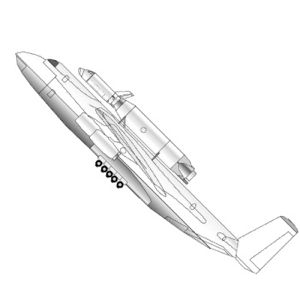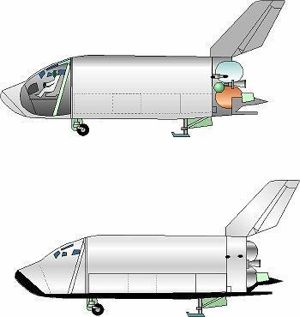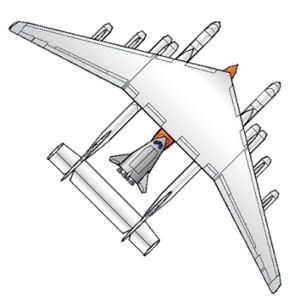
Home - Search - Browse - Alphabetic Index: 0- 1- 2- 3- 4- 5- 6- 7- 8- 9
A- B- C- D- E- F- G- H- I- J- K- L- M- N- O- P- Q- R- S- T- U- V- W- X- Y- Z
System 49
 49 / An-124 |
Status: Study 1981. Payload: 4,000 kg (8,800 lb). Gross mass: 200,000 kg (440,000 lb). Apogee: 200 km (120 mi).
The Spiral project was not cancelled with the decision to proceed with the large Buran spaceplane. Instead flight test of the orbiter continued but the launcher design was rethought. The ambitious Mach 4 air-breathing first stage was abandoned. Instead the rocket stages and the manned Spiral orbiter were mounted on the back of an An-124 subsonic transport. This concept would evolve through the Bizan concept to the MAKS of the 1980's, which reached the hardware development stage.
The first iteration of the new design was undertaken in 1977-1978 as the AKS project at the Scientific Research Institute 'Rosa'. This used the second rocket stage and orbiter stage of Spiral, designated RUOS in this study.
The subsequent System 49 design used a refined Spiral configuration proven in flight tests of the MiG-105-11 and BOR-4. The combined orbiter and rocket stages, weight 200 metric tons, would be launched from the An-124 at an altitude of 10 km and a speed of Mach 0.7. Effective velocity gain compared to a vertical launch from the ground was 270 m/s.
The first stage would use Lox/Kerosene propellants and 2 NK-43 / 11D112 engines. The second stage was equipped with a single RD-57M / 11D57M engine burning Lox/LH2 propellants. Two rocket stage layouts were studied: a traditional tandem scheme, and a 'piston' / 'wrap around' concept, where the toroidal propellant tanks of the first stage surrounded the second stage.
The orbiter would have a mass of 13 metric tons, and could deliver a payload of 4 metric tons to orbit in a 27 cubic meter payload compartment (dimensions 6.0 m long x 2.8 m x 1.6 m). Orbits from 120 to 1000 km altitude, and 45 to 94 degrees inclination could be achieved thanks to the flexibility of airborne launch. The orbiter was flown by a single pilot, had sufficient consumables for 5 to 12 hours of on-orbit operations, and was designed for 100 reuses. It could achieve up to 1000 km cross-range during re-entry and landed at a speed of 300 to 310 km/hr.
The design was found to be feasible but to have little growth potential. Greater payload could only be achieved by the completely different 49M using a new super-heavy carrier aircraft and orbiter. Therefore it was succeeded in the design studies by the 'Bizan' concept.
LEO Payload: 4,000 kg (8,800 lb) to a 200 km orbit at 51.00 degrees.
| System 49 Orbiter Orbiter for the System 49 launch system, with a single crew member. |
| System 49-M Russian winged orbital launch vehicle. The 49M was an application of the system 49 design concept, but with a larger carrier aircraft. The system would have a 770 metric ton gross takeoff mass. |
Family: aircraft-launched, orbital launch vehicle, Winged. Country: Russia. Spacecraft: System 49 Orbiter. Agency: Molniya bureau. Bibliography: 458.
 | 49 Orbiter |
 | 49M |
1977 - . Launch Vehicle: System 49.
- System 49 air-launched spaceplane design begun - .
Nation: Russia.
The Spiral project was not cancelled with the decision to proceed with the large Buran spaceplane. Instead flight test of the orbiter continued but the launcher design was rethought. The ambitious Mach 4 air-breathing first stage was abandoned in favour of launch from an existing subsonic heavy transport. The first iteration of the new design was undertaken in 1977-1978 as the AKS project at the Scientific Research Institute 'Rosa'. This used the second rocket stage and orbiter stage of Spiral, designated RUOS in this study. This design was the starting point that would evolve through the System 49 and Bizan designs, finally resulting in the MAKS of 1988.
The System 49 design had the same arrangement as Spiral. The rocket stages and the Spiral orbiter were mounted on the back of an An-124 subsonic transport. By the time of the design, the Spiral configuration had been proven in the MiG-105-11 and BOR-4. The combined orbiter and rocket stages, weight 200 tonnes, would be launched at an altitude of 10 km and a speed of Mach 0.7. Effective velocity gain compared to a vertical launch from the ground was 270 m/s.
The first stage would use Lox/Kerosene propellants and 2 NK-43 / 11D112 engines. The second stage was equipped with a single RD-57M / 11D57M engine burning Lox/LH2 propellants. Two rocket stage layouts were studied: a traditional tandem scheme, and a 'piston' / 'wrap around' concept, where the toroidal propellant tanks of the first stage surrounded the second stage.
The orbiter would have a mass of 13 tonnes, and could deliver a payload of 4 tonnes to orbit in a 27 cubic metre payload compartment (dimensions 6.0 m long x 2.8 m x 1.6 m). Orbits from 120 to 1000 km altitude, and 45 to 94 degrees inclination could be achieved thanks to the flexibility of airborne launch. The orbiter was flown by a single pilot, had sufficient consumables for 5 to 12 hours of on-orbit operations, and was designed for 100 reuses. It could achieve up to 1000 km cross-range during re-entry and landed at a speed of 300 to 310 km/hr.
The design was found to be feasible but to have little growth potential. Greater payload could only be achieved by the completely different 49M using a new super-heavy carrier aircraft and orbiter. Therefore it was succeeded in the design studies by the 'Bizan' concept.
Back to top of page
Home - Search - Browse - Alphabetic Index: 0- 1- 2- 3- 4- 5- 6- 7- 8- 9
A- B- C- D- E- F- G- H- I- J- K- L- M- N- O- P- Q- R- S- T- U- V- W- X- Y- Z
© 1997-2019 Mark Wade - Contact
© / Conditions for Use